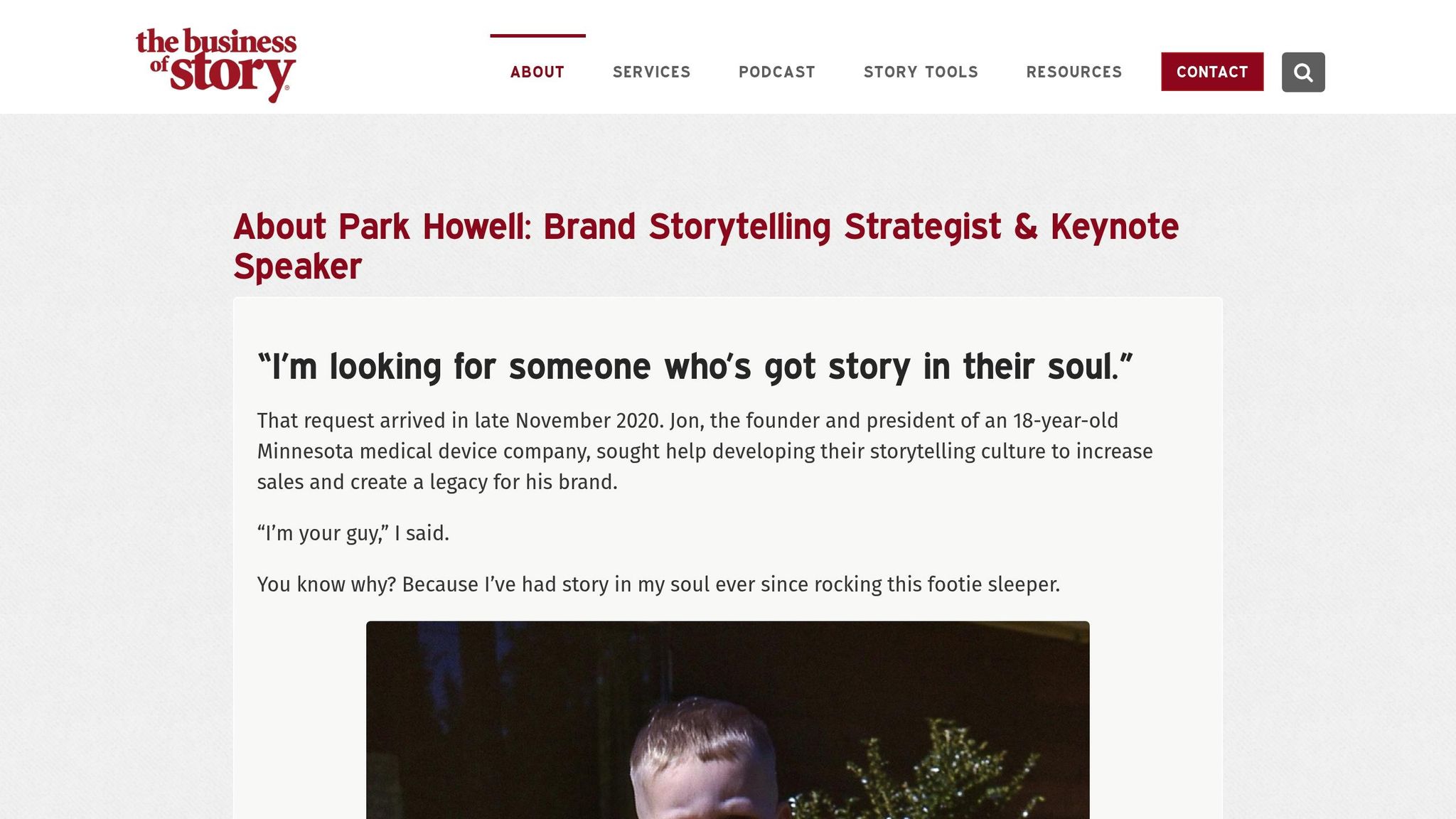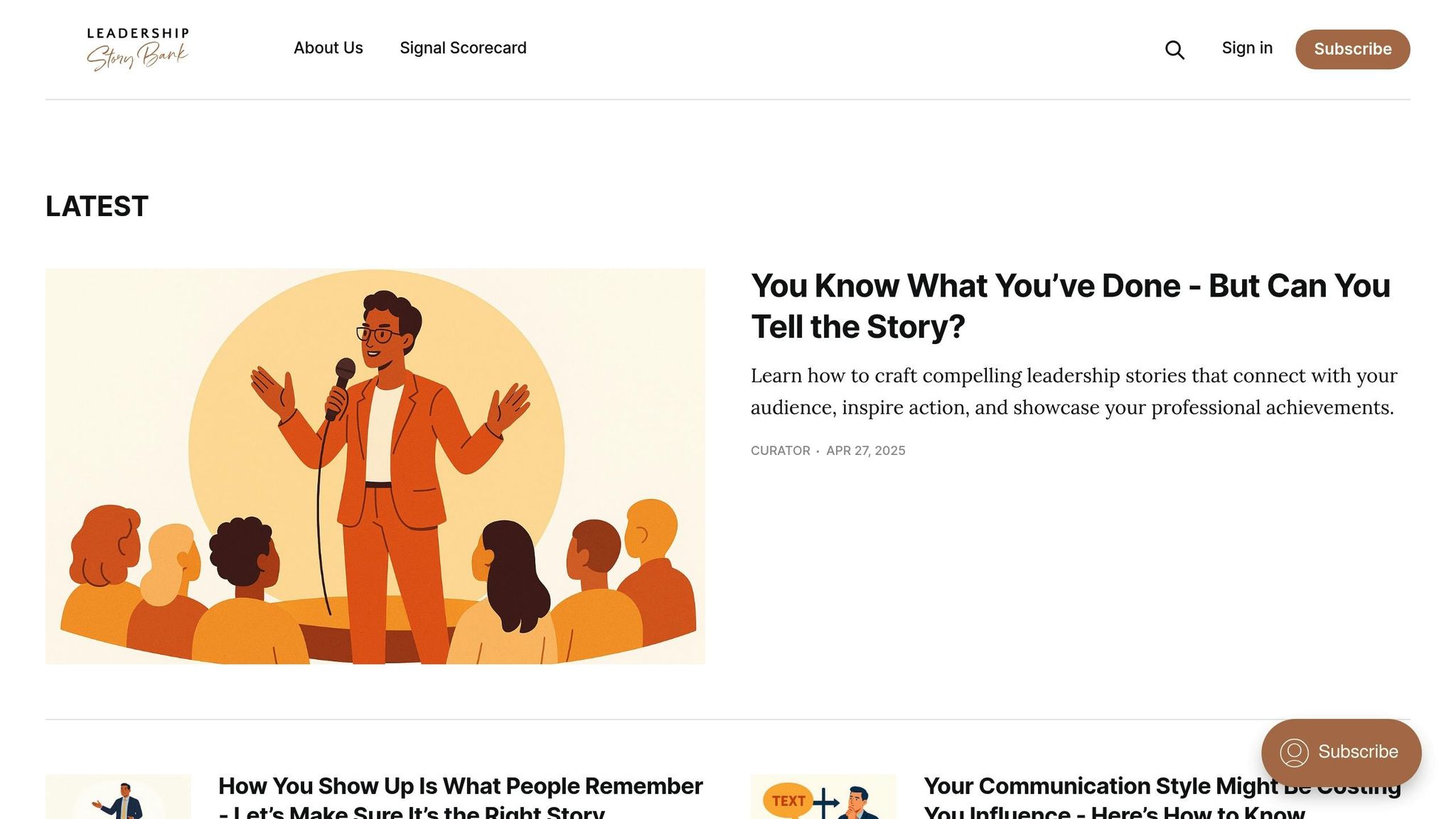ABT Framework for Leadership Stories
Learn how the ABT framework enhances leadership storytelling, fostering team engagement and clear communication through structured narratives.

The ABT Framework (And, But, Therefore) is a simple storytelling method for leaders to communicate clearly and connect with their teams. It breaks ideas into three parts:
- And: Set the stage with context and shared goals.
- But: Highlight challenges or problems.
- Therefore: Offer solutions and actionable steps.
Why Use ABT in Leadership?
- Builds trust and psychological safety.
- Increases team engagement and clarity.
- Simplifies complex ideas into relatable narratives.
- Drives action and improves productivity.
How to Apply ABT:
- Start with facts or shared experiences (And).
- Introduce the main challenge (But).
- Provide solutions and outcomes (Therefore).
This framework works for meetings, presentations, and team updates, helping leaders inspire and guide their teams effectively.
The ABTs of Storytelling: Leadership Today w/ Park Howell

The 3 Parts of ABT
Each part of the ABT framework guides leadership narratives through a structured process. Here's a closer look at how each stage works and how to apply it effectively.
'And': Setting the Stage
The 'And' stage lays the groundwork by providing context that resonates with your audience. It’s all about framing the narrative in a way that everyone can connect with and agree on. Here’s how to build this foundation:
| Element | Purpose | Application |
|---|---|---|
| Context | Frame the narrative | Align team vision |
| Facts | Support key points | Highlight current issues |
| Situation | Define the current state | Identify strategic goals |
| Agreement | Establish common ground | Focus on shared objectives |
The goal is to create a solid base of understanding before introducing any challenges.
'But': Highlighting the Problem
The 'But' stage introduces the challenge - this is where the story takes a turn and tension is created. It’s essential to make this part impactful.
Key elements to focus on:
- Specific Problems: Clearly outline the issues at hand.
- Impact: Explain how these problems affect team and organisational goals.
- Emotional Connection: Add urgency by showing why the challenge matters.
- Stakes: Highlight the risks of not addressing the problem.
This step sets the stage for offering a solution that feels both necessary and urgent.
'Therefore': Offering the Solution
The 'Therefore' stage is where you provide the resolution, turning the tension into actionable steps. This is your chance to bring everything together and drive action.
- Tie Back to the Context: Directly connect your solution to the context and problems you’ve outlined.
- Show Clear Outcomes: Highlight the measurable results your solution will deliver.
- End with a Call to Action: Provide specific steps your audience can take to move forward.
| Resolution Element | Key Focus | Desired Outcome |
|---|---|---|
| Solution Link | Connect to the problem | Show clear progression |
| Action Steps | Outline specific tasks | Create an implementation path |
| Expected Results | Define measurable goals | Track success metrics |
| Timeline | Provide a schedule | Aid in project planning |
This final stage ties everything together, ensuring your narrative feels complete and actionable.
Building Stories with ABT
Use the ABT framework to craft narratives that inspire and achieve leadership goals.
Define Your Story Goal
Start by identifying a clear purpose for your story that aligns with your organisation's objectives. Your narrative should aim to create measurable outcomes.
| Goal Type | Purpose | Example Application |
|---|---|---|
| Strategic | Align with long-term vision | Team transformation efforts |
| Tactical | Drive immediate action | Achieving project milestones |
| Cultural | Shift values and behaviours | Adopting new processes |
| Developmental | Encourage growth and learning | Skill-building programmes |
When addressing organisational change, focus on stories that connect challenges with opportunities. This approach helps make the journey relatable and engaging for your team.
Choose Your Story Elements
Pick elements that strengthen your narrative and align with the goal:
Key Elements:
- Share personal experiences that resonate.
- Include relevant challenges your team or organisation has faced.
- Highlight significant decisions made along the way.
- Showcase measurable results to demonstrate impact.
Only include elements that add value to your story. Once selected, structure them using the ABT framework.
Apply the ABT Structure
-
'And' Elements
Begin with facts or shared experiences to establish common ground. -
'But' Transition
Introduce the main challenge and its consequences. -
'Therefore' Resolution
Offer solutions and insights, tying them back to the context and challenges faced.
Making ABT Stories More Effective
Adjust Stories for Different Settings
Customise your ABT framework based on the setting by tweaking the details and language to suit your audience's level of expertise:
| Setting | Story Length | Key Focus | Example Application |
|---|---|---|---|
| Board Meetings | 2-3 minutes | Strategic focus | Quarterly results and future plans |
| Team Updates | 5-7 minutes | Operational details | Project progress and challenges |
| Client Presentations | 10-15 minutes | Value proposition | Case studies and proposed solutions |
| Training Sessions | 15-20 minutes | Learning outcomes | Skill-building exercises |
Connect with Your Audience
Engaging your audience through storytelling requires careful attention to how they respond and interact. Here are some ways to strengthen that connection:
Active Listening Signals
- Watch for nonverbal cues like nods or frowns.
- Take note of how the audience reacts to key points.
- Adjust your pace and tone based on their feedback.
Emotional Resonance
Tap into challenges your audience relates to. Use shared experiences to create a bridge between your story and their reality.
Cultural Awareness
Be aware of cultural differences when presenting to diverse teams or regions. A story that resonates in Manchester might need tweaking for audiences in Glasgow or Cardiff.
These techniques help ensure your 'Therefore' conclusion resonates strongly with your audience.
Common Mistakes to Avoid
Sidestep these errors to make your ABT story more impactful:
- Overcomplication: Stick to one conflict. Adding multiple 'But' moments can confuse your audience.
- Insufficient Context: Build up enough context and tension before introducing your solution.
Quick Fix Guide:
- Use specific examples to clarify your points.
- Cut out unnecessary jargon and focus on clear outcomes.
- Keep all details tied to your main message.
Storytelling improves with practice. Record yourself delivering your stories, then review the recordings to refine your structure and delivery.
Leadership Story Bank Tools

Leadership Story Bank uses the ABT (And, But, Therefore) framework to help leaders sharpen their storytelling skills. Its tools are designed to make your narratives more engaging and impactful in various business scenarios.
About Leadership Story Bank
This platform focuses on helping leaders create meaningful stories that resonate and inspire. By applying the ABT framework, it supports leaders in crafting narratives that are clear, compelling, and tailored to their audiences.
Key Focus Areas:
- Developing strategic communication skills
- Refining personal narratives
- Strengthening leadership presence
- Mastering techniques to influence stakeholders
Story Development Features
Leadership Story Bank includes tools that guide you in structuring your stories with the ABT framework:
Story Structure Builder
This tool provides step-by-step prompts to help you:
- Pinpoint important story elements
- Highlight key conflicts
- Outline resolution strategies
- Test how well your story flows
Framework Application Guide
| Story Element | Purpose | Key Questions |
|---|---|---|
| And (Setup) | Set the stage | What’s the current situation? |
| But (Conflict) | Introduce the challenge | What obstacle arose? |
| Therefore (Resolution) | Conclude with results | How was the issue resolved? |
These guidelines simplify the process of building a solid narrative foundation before you expand your story collection.
Building Your Story Collection
A well-rounded collection of leadership stories equips you to handle diverse situations with confidence. Here are some categories to consider:
Strategic Stories
Focus on narratives that highlight:
- Vision and goal-setting
- Driving change initiatives
- Embracing transformation
- Aligning teams effectively
Tactical Stories
Showcase examples that cover:
- Problem-solving methods
- Decision-making strategies
- Collaborative achievements
- Lessons learned from challenges
Tips for Managing Your Stories:
- Write down stories soon after key events
- Regularly review and improve your narratives
- Share stories with trusted colleagues for feedback
- Tailor stories to suit different audiences
Conclusion
The ABT (And, But, Therefore) framework offers a practical way to improve storytelling and strengthen leadership communication. It's a simple yet powerful tool that enhances how leaders connect with their teams and navigate organisational challenges.
Using ABT in storytelling can positively impact team dynamics, helping to boost performance and engagement across various settings. Its flexibility makes it suitable for different leadership scenarios, ensuring messages are clear and impactful.
Benefits of Using the ABT Framework:
- Strengthens team connections
- Simplifies the communication of complex ideas
- Supports effective organisational change
- Builds executive presence and trust
- Delivers memorable and impactful messages
Despite its straightforward structure, ABT has the potential to elevate communication at all levels of leadership. In a world where leaders face growing complexities, mastering this framework can help them inspire and influence more effectively.
FAQs
How does the ABT framework help leaders improve team engagement and communication clarity?
The ABT framework (And, But, Therefore) is a simple yet powerful storytelling tool that helps leaders structure their messages for maximum impact. By clearly outlining the context (And), identifying the challenge or conflict (But), and offering a resolution or call to action (Therefore), leaders can deliver messages that are both engaging and easy to follow.
In a leadership setting, this framework can enhance team engagement by creating narratives that resonate emotionally and logically with team members. It also improves communication clarity by eliminating unnecessary details and focusing on what truly matters, helping teams stay aligned and motivated towards shared goals.
What are common pitfalls leaders face when using the ABT framework, and how can they overcome them?
One common mistake leaders make with the ABT framework is overcomplicating their stories. The ABT (And, But, Therefore) structure is designed to create clarity and focus, so avoid adding unnecessary details or trying to include too many ideas. Stick to one central message to ensure your story remains impactful and easy to follow.
Another pitfall is neglecting the emotional connection. While the framework provides structure, it’s essential to weave in authentic emotions and relatable experiences. This helps your audience connect with your story on a deeper level, making it more memorable and engaging.
To avoid these issues, practice crafting concise, focused stories and test them with trusted colleagues or mentors. Feedback can help you refine your message and ensure it resonates with your audience effectively.
How can leaders adapt the ABT framework for settings like board meetings or client presentations?
The ABT framework (And, But, Therefore) is a versatile tool that leaders can tailor to various professional settings to ensure their messages are clear and compelling. For board meetings, it can help structure updates or proposals by presenting the current situation (And), highlighting challenges or opportunities (But), and outlining actionable solutions (Therefore). In client presentations, it can enhance storytelling by connecting with the audience's needs, addressing potential concerns, and demonstrating how your solution meets their objectives.
By focusing on clarity and narrative flow, the ABT framework ensures your communication is both impactful and easy to follow, regardless of the audience or context.



